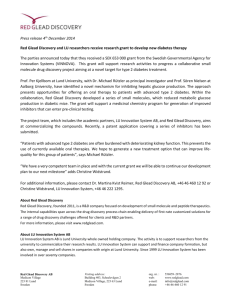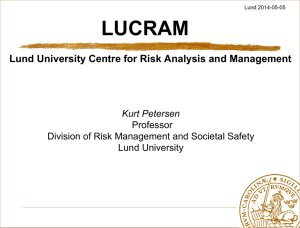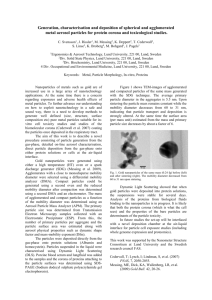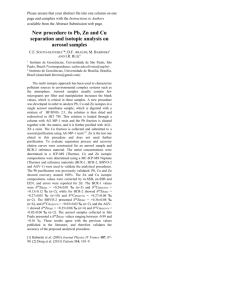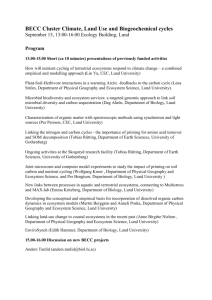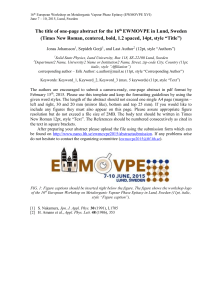Supporting information for Nano
advertisement
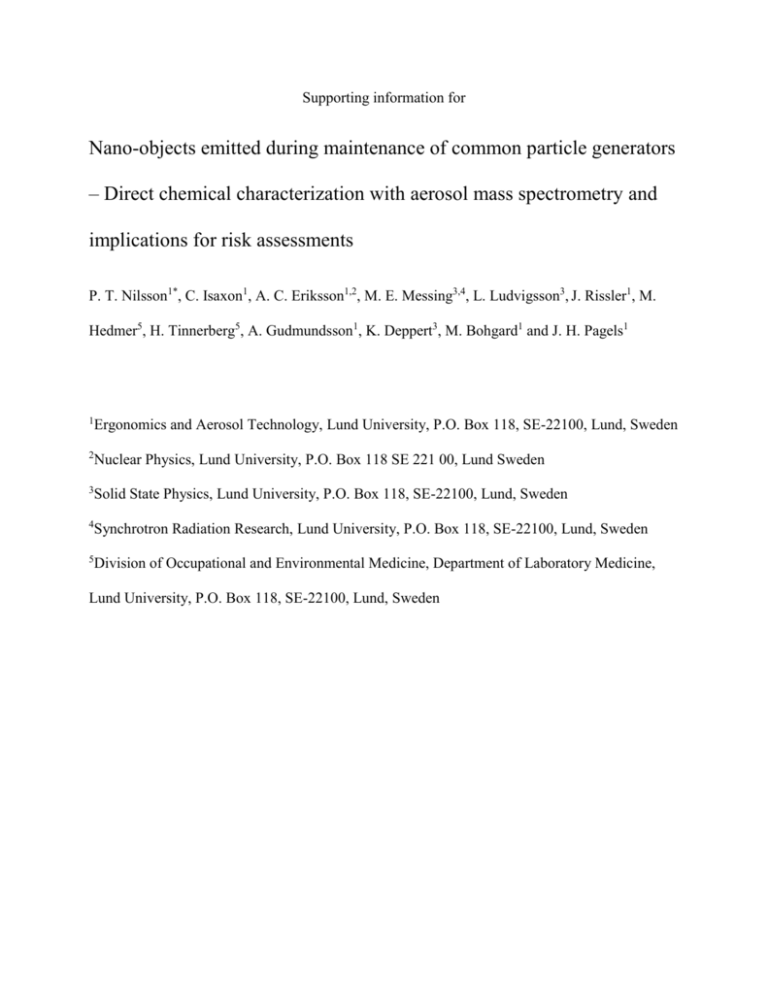
Supporting information for Nano-objects emitted during maintenance of common particle generators – Direct chemical characterization with aerosol mass spectrometry and implications for risk assessments P. T. Nilsson1*, C. Isaxon1, A. C. Eriksson1,2, M. E. Messing3,4, L. Ludvigsson3, J. Rissler1, M. Hedmer5, H. Tinnerberg5, A. Gudmundsson1, K. Deppert3, M. Bohgard1 and J. H. Pagels1 1 Ergonomics and Aerosol Technology, Lund University, P.O. Box 118, SE-22100, Lund, Sweden 2 Nuclear Physics, Lund University, P.O. Box 118 SE 221 00, Lund Sweden 3 Solid State Physics, Lund University, P.O. Box 118, SE-22100, Lund, Sweden 4 Synchrotron Radiation Research, Lund University, P.O. Box 118, SE-22100, Lund, Sweden 5 Division of Occupational and Environmental Medicine, Department of Laboratory Medicine, Lund University, P.O. Box 118, SE-22100, Lund, Sweden Figure S1. Schematic of the particle generator setup that was maintained. The high temperature furnace (HT furnace) and the spark discharge generator (SDG) were placed upstream a sintering furnace and a differential mobility analyzer (DMA). Number concentration [cm-3] 1 000 100 10 CPC (>0.02 m) APS (> 0.5 m) 1 0.1 00:00 SDG HT 00:05 00:10 Time [hh:mm] 00:15 Figure S2. Total particle number concentration during maintenance of the HT Furnace (HT) and the spark discharge generator (SDG) obtained during a second measurement day. During this measurement emitted particles were collected on filters for SEM-EDX analysis and the LV-AMS was used in particle time of flight (PToF) mode. AMS data processing The AMS is operated by modulating the particle beam, formed by the inlet aerodynamic lens, with a mechanical chopper which, in MS mode, is alternated in a way that it is blocking or allowing the particle beam to pass through it. With the chopper at blocked position no particles are allowed to pass and travel through the vacuum chamber to the heated plate or the perpendicular positioned YAG laser. Thus, no particles are vaporized. This part of the chopper duty cycle is used to determine the instrument background which is subtracted from the values obtained when the chopper is opened. Gaussian fits are applied to the difference spectra (diff=opened-closed) and the fits are used to identify and quantify specific ion fragments. With high resolution mass spectra it is possible to clearly differentiate between signals that are due to metals and organic impurities, for example different types of hydrocarbons. Figure S3 shows a high resolution mass spectra with fitted peaks separated by about 0.2 amu at the same nominal m/z (56). Figure S3. Signal intensity of free different ion fragments at the same nominal m/z (56). The 56 Fe+, at 55.9349 amu, is below the nominal m/z while the identified organic fragments (C3H6N+ and C4H8+) are located above the nominal m/z (56.0500 and 56.0626 respectively). In the case of metals the known isotopic abundances can be used to evaluate the fitting procedure and to verify the results. Figure S4 and S5 show the determined isotopic abundances for Pd and Ag for all measurement points obtained during the maintenance procedure. The abundances have been obtained by finding the slopes of the lines belonging to the sum of signal strength for all isotopes versus each specific isotope1. The major isotopes where determined to be within 5 % of the tabulated abundances2. Specific Isotope (Hz) 600 y = 0.521x 500 y = 0.479x 400 300 Ag107 Ag109 200 100 0 0 200 400 600 800 1,000 1,200 Sum Ag isotopes (Hz) Figure S4. Isotopic abundances of Ag. The slopes of the lines correspond to each specific isotopic abundance which can be compared to the tabulated values (107Ag: 0.518, 109Ag: 0.482) 600 y = 0.271x Specific isotope (Hz) 500 400 y = 0.260x y = 0.222x Pd106 Pd108 300 y = 0.124x 200 y = 0.115x Pd110 Pd104 100 y = 0.008x 0 0 500 1,000 Sum Pd isotopes (hz) 1,500 2,000 Pd105 Pd102 Figure S5. Isotopic abundances of Pd. The slope of the lines correspond to each specific isotopic abundance which can be compared to the theoretical values( 102Pd: 0.010, 104Pd: 0.111, 105Pd: 0.223, 106Pd: 0.273, 108Pd: 0.265, 110Pd: 0.117) For quantitative measurements the signal strength, given by the AMS in Hz (ions/s), has to be transformed to a mass basis. A nitrate equivalent mass concentration (Cs) for s specific chemical specie (s) can be determined from the AMS measurements by using the following equation3: 𝐶𝑠 = ∑𝑖 𝐼𝑠,𝑖 𝑅𝐼𝐸𝑠 ∗ 𝑚𝐼𝐸𝑁𝑂3 ∗ 𝑄 where ∑𝑖 𝐼𝑠,𝑖 is the summed ion signal for all ion fragments (or isotopes), RIEs is the relative ionization efficiency for specie s to nitrate, mIENO3 is the mass specific ionization efficiency of nitrate (ions/pg) and Q is the sample flow rate. RIEs is defined as: 𝑅𝐼𝐸𝑠 = 𝑚𝐼𝐸𝑠 𝑚𝐼𝐸𝑁𝑂3 where mIEs is the mass specific ionization efficiency of specie s given in ions/pg. Preliminary results show that the mass specific ionization efficiencies for the metals analyzed in this work lies in the range of 20-30 below the factor for nitrate (mRIENO3=800 ions/pg). Measurements performed with the specific LV-AMS instrument used in this study, show that the mass specific ionization efficiencies for the metal elements are a factor of 20 lower than the ionization efficiency for nitrate. By assuming such mass specific ionization efficiencies the 10 s detection limit in terms of mass concentration becomes 0.20 µg/m3 for Fe and 0.01 µg/m3 for Au. Because of the uncertainty in the collection and ionization efficiencies for the sampled particles the quantitative analysis is however approximate. Full calibration measurements lies beyond the scope of this paper. In on-going work we aim to characterize and establish the ionization and collection efficiencies for different metal species as a function of particle size, including metaloxides, to further broaden the applicability of the LV-AMS. References 1. Cross, E. S.; Sappok, A.; Fortner, E. C.; Hunter, J. F.; Jayne, J. T.; Brooks, W. A.; Onasch, T. B.; Wong, V. W.; Trimborn, A.; Worsnop, D. R.; Kroll, J. H., Real-Time Measurements of Engine-Out Trace Elements: Application of a Novel Soot Particle Aerosol Mass Spectrometer for Emissions Characterization. J Eng Gas Turb Power 2012, 134 (7). 2. Scientific Instrument Services (2012), Exact masses and Isotopic Abundances, http://www.sisweb.com/referenc/source/exactmaa.htm. 3. Onasch, T. B.; Trimborn, A.; Fortner, E. C.; Jayne, J. T.; Kok, G. L.; Williams, L. R.; Davidovits, P.; Worsnop, D. R., Soot Particle Aerosol Mass Spectrometer: Development, Validation, and Initial Application. Aerosol Sci Tech 2012, 46 (7), 804-817.
